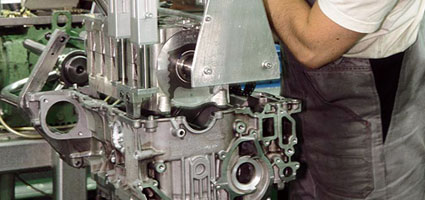Another description by WP1206 22/8/04 on tis thread http://www.porscheclubgbforum.com/fb.asp?m=71682
'This may be of interest to you all. I talked to a very knowledgeable long time
engine builder recently. Looking over a 993 engine in pieces in his workshop the
subject of 996/Boxster engine design came up. He used the disassembled 993
engine to talk me through both the 993 and 996/Boxster engine designs. The
996/Boxster engine has some very nice design elements. The subject came around
eventually to RMS and engine failures.
I do not have the specialist knowledgeable to know if my memory or understanding
is 100% accurate but wanted to post the result of the discussion to maybe help
with your ongoing discussions as all knowledge is good. I can claim a mechanical
engineering background but the following should be taken as non-official,
unverified, blah blah blah.
I will make the description as simple as possible whilst describing the relevant
points.
I'll start by describing the crankshaft arrangement in the engines pre
996/Boxster that were last seen in the 993. In these engines the crankshaft
arrangement is something like this.
a/ Starting at one end of the crankshaft you have the intermediate shaft drive.
The intermediate shaft is driven directly by having a gear wheel on the
crankshaft and a gear wheel on the intermediate shaft.
b/ In the middle are the connecting rods to the pistons.
c/ At the other end of the crankshaft is the final crankshaft bearing (I have
not described any other bearings as not directly relevant) followed immediately
by the rear main seal (RMS) followed by the dual mass flywheel outside the
crankcase.
For the 996/Boxter engine redesign a number of things where changed in this
layout. First the intermediate shaft drive was changed from direct gear wheel to
a chain and sprocket type of drive. Also the intermediate shaft drive was moved
to the other end of the engine between the final crankshaft bearing and the rear
main seal (RMS). So in summary the layout looks like this
a/ Starting at one end of the crankshaft you have some stuff (no detail given
here as not directly relevant).
b/ In the middle are the connecting rods to the pistons.
c/ Then the final crankshaft bearing (I have not described any other bearings as
not directly relevant).
d/ Then the intermediate shaft drive (sprocket and chain).
e/ Then the main seal (RMS).
f/ Finally the dual mass flywheel outside the crankcase.
The possible fault with this design is the distance between the final crankshaft
bearing and the dual mass flywheel. What happens is that the crankshaft bends
under use probably exacerbated by the weight and therefore the rotational forces
caused by the heavy dual mass flywheel. Once the crankshaft has bent it starts
to wobble at the flywheel end and no longer revolves in true around its centre
line. This could cause the following problems.
a/ Rear main seal (RMS) to fail. As the crankshaft is bent is revolves out of
centre and the seal is not designed to deal with this. Eventually the seal no
longer forms a full seal to the crankshaft as it gets deformed in effect to have
a slightly larger hole in the middle through which the oil leaks.
b/ Failure of the intermediate shaft and therefore catastrophic failure of the
engine. Because the crankshaft is no longer true this results in the chain to
the intermediate shaft being stretched then loosened on every revolution. It’s
a sort of jerking movement. It would eventually cause either the chain drive to
fail or the intermediate shaft itself to bend with subsequent damage to bearings
etc.
c/ Vibrational forces at the rear of the crankshaft around the rear bearing.
It’s unknown what this might cause'
Another link to the RMS survey thread
http://www.porscheclubgbforum.com/fb.asp?m=129297
The GT3 and TT have the same crankshaft, cylinder liners and cylinder
blocks, all based on the GT1, and different to the M96 engine, that's why they do not suffer from RMS failures.
.










